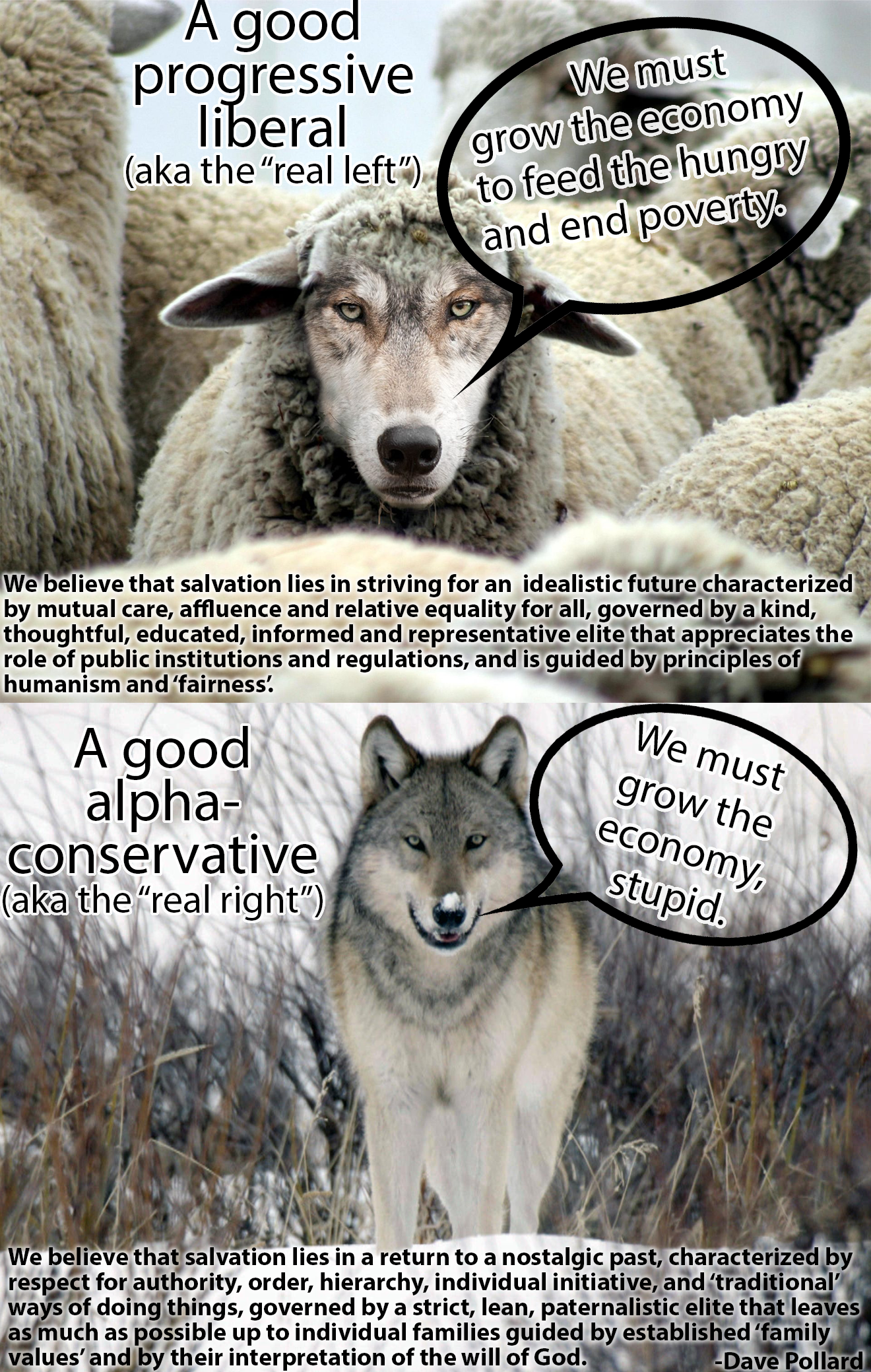
WEDNESDAY, AUG 29, 2021: NOTE TO FILE

99% die-offs in environments that remain 99.998% unoccupied?
Many humans claim (see Quora) that we could all live on Unguja in apartments just a few stories high or in Texas with everyone not wanting to live in a city having a spacious suburban home lot, so clearly earth is still 99.998% empty.
by Randolph Femmer
TOPICS: OVERSHOOT AND COLLAPSE IN VAST SPACES, FROM THE WIRES, 99.998% EMPTY
Intro: This paper from about 2012, with 29 views, is of greater interest than any I've read in the last ten years. Only well known information is cited, "classic" studies, but of interest is the better than I've known interpretation of the data. Garrett Hardin noted that most modern humans are semiliterate, innumerate, and cluelessly unaware of being inecolate. Literacy would include science literacy which over the last 50 years includes systems science literacy (ecolacy), a needed pillar of the educated mind. Most scientists are not ecolate, and few citizens are even literate in one or more silo sciences, hence at best the 'well educated' products of the Modern Techno-Industrial 'education system' (schooling system) are at best semiliterate. Information in graphs requires some numeracy to appreciate, so wordsmith writers and their readers (e.g. NYT, National Review, Atlantic...) religiously avoid graphs and tables (data), and would suffer death before sprinkling even one equation on their word salad. I mention the obvious to note that Randolph Femmer, a high school biology teacher, is an example of an educated human such as Garrett Hardin envisioned if humanity is to persist. The source hosting the paper (for-profit Academia.edu) demands you forfeit all personal information (e.g. all gmail contacts) to access the pdf version, and they thwart any attempt to copy text from the preview or images, so to liberate, about half had to be typed and screenshots edited to recover images. This level of disregard looks like evidence of the universal denial we swim in, which all Anthropocene enthusiasts do (swimmingly, of course). It's easy when you know how (and would rather believe than know how the world really works).
COOS BAY (A-P) — Clean text version:
This article assesses THREE classical, separate, independent and quintessential real-world population-environment calamities that all took place when the combined bodies (or cells) of the populations involved, physically-occupied roughly 2/1000ths of 1% of the total environmental area or volume that, visually-speaking, appeared to remain theoretically available to them (see tiny white dot in the image below). In other words, ALL THREE real-world calamities began (or were already well-underway) in "vast open-space" conditions (roughly 99.998% unoccupied) that visually appeared to remain ALMOST ENTIRELY EMPTY. The data sets assessed involve routine outbreaks of dinoflagellate red-tide (e.g. Karenia brevis) in marine environments (which induce environmental calamity by their release of wastes into their surroundings), and two separate and classical climb-and-collapse studies of mammalian population (reindeer herds, Rangifer tarandus) on Alaskan islands (Scheffer 1951 and Klein 1968). All three offer disquieting testimony concerning humankind's "vast open-space" suppositions.

Three separate, classical, independent, and quintessential examples of population-environment calamities that occur in "vast open-space" conditions and environmental surroundings that visually appear to remain ALMOST ENTIRELY EMPTY.
This article outlines the supporting mathematics for each of the three examples cited above (see appendices) and discusses their potential implication for humankind. Given, for example, the visual appearance of such seemingly vast 99.998% "unoccupied" and open-space conditions, it would be extraordinarily difficult for even the most intelligent, thoughtful, and scholarly members of a sentient species to imagine either the degree or the proximity of the imminent 99% die-offs and/or mass-mortalities that are about to overtake them when such "vast amounts of open-space" appear to remain theoretically available in their surrounding environments, or which were actually already underway. What all three of our classical examples show quite powerfully, however, is that if the scholars and leaders of such populations wait until the conditions depicted above develop, they will have ALREADY WAITED TOO LONG.
Synopses of each of the three data sets assessed
The first data that we assessed involved classical outbreaks of dinoflagellate red-tide in marine environments. Such population explosions of one-celled dinoflagellates (e.g. Karenia brevis) constitute one of nature's quintessential examples of population explosions that culminate in mass mortalities and environmental catastrophes. A typical catastrophic outcome, which may include deaths of millions of tons of fish (and even, for example, manatees) occurs as the cells responsible for the calamity reach, approach, or exceed densities of approximately 1,000,000 cells per liter [1]. In such outbreaks, dinoflagellate populations release toxins (brevetoxins) into their surroundings (a characteristic worth noting, perhaps, since our own species appears to exhibit an extraordinarily-similar pattern of behavior.
In this first assessment then, the results reported here show that all one million K. brevis cells per liter, when taken together, physically occupy a combined volume of less than 2/1000ths of 1% of the one liter water samples in which they reside. In other words, they induce calamity (by their production and release of wastes) in seemingly "vast open ocean conditions" and in surroundings that visually appear to remain ALMOST ENTIRELY EMPTY. What this mathematics shows (and the rectangle that opens this article depicts), is that these enormous red-tide outbreaks reach, breach, and transgress calamitous population-environment thresholds at a time when all 1,000,000 dinoflagellate cells per liter, when taken together, could physically-fit into the tiny white dot in this article's opening image and in environmental surroundings that remain roughly 99.998% unoccupied.
The second study that we assessed was V.B. Scheffer's classic description of the rise and fall of a reindeer herd on St. Paul Island, Alaska reported in 1951 (Scientific Monthly 73:356-362). That herd began in 1911 when the U.S. government introduced 25 reindeer to the approximately 106 km2 island in the Bering Sea (the article cites 26,500 acres). By 1938 the herd's population peaked at more than 2000 individuals, after which a nearly annihilating 99% die-off began which left just eight individuals remaining by the study's close in 1950. (Our assessment in this report shows that at the herd's peak population, their combined bodies physically occupied roughly 2/1000ths of 1% of their island's total area, so that their peak population and their 99% plus die-off both took place in surroundings that were 99.998% unoccupied.)
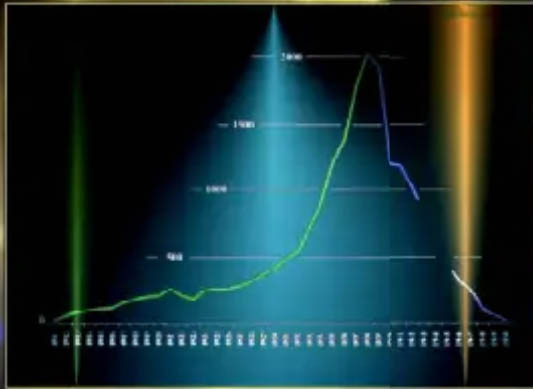
The graph shown above (after Scheffer, 1951) depicts the classical climb-and-collapse data set of the study. Note that the graph of this classical, real-world population study does not exhibit a logistic or sigmoid-curve, but instead exemplifies the other classical population outcome known as climb-and-collapse. (The gap in the graph reflects data that were not able to be collected during World War II.)
The third study that we assessed was another separate and independent reindeer study reported by D.R. Klein in 1968 entitled The introduction, increase, and Alaska (Journal of Wildlife Management 32:350-367). This study began in 1944 when 29 reindeer (Rangifer tarandus) were introduced to the island. In the ensuing years, the herd increased to more than 6000 individuals by 1963, followed by a "nearly annihilating" 99% collapse prior to the close of the study in 1966. (The assessment in this report also shows that in this separate population, their combined bodies physically occupied roughly 2/1000ths of 1% of this island's total area as well, so that their peak population and their 99%-plus die-off both took place in surroundings that were 99.998% unoccupied.) (See appendices for the supporting math for all three above assessments.)
Preliminary Discussion
The data sets assessed show that in each of the three classical calamities that we examine, the opens pace conditions in which the mortalities or die-offs begin (or which are already well underway) do not constitute unique or unusual real-world events, but instead constitute quintessential real-world transgressions of boundaries, thresholds, tipping points, and carrying capacities under "vast open-space" conditions.

Thus, it is provocative to note that, in ALL THREE studies assessed here, the tiny white dot in our lead image does not denote a 'possible' or 'potential' crisis that will soon require, necessitate, or demand attention. Instead, for all three classical real-world studies, the tiny 2/1000ths of 1% dot actually denotes a moment in time that is already "TOO LATE" (in other words, a moment in time in which members of all three populations have already waited 'TOO LONG'). Thus this article's lead image (and the studies it reflects) denotes, for all three cases, a critical population-environment threshold that has ALREADY BEEN BREACHED, so that, if any of the populations were to avoid the calamitous outcomes that the image threshold denotes, their precautionary measures would have been required MUCH SOONER.
How much sooner? To avoid calamity, each of the three populations would need to have stabilized their populations AT LEAST one or two (or for true safety, perhaps three or four) "doubling-times" sooner. If that is the case, it would be necessary for the organisms, their societies, and their leaders to recognize, enunciate, and act upon their trajectories, implications, and outcomes at a time when the "combined occupancy dot" that they occupy is just one-half or one-quarter (or one-eighth or one-sixteenth) of the size of the dot depicted in our image.
Thus, if the populations in each of the three examples that we cite were to avoid calamity, their precautionary and preventative actions would have been necessary at a far earlier point in time when they would have still had time in which to initiate preventive actions (one, two, or three or more doublings earlier). To display an image that denotes such earlier conditions would require a rectangle of the same size as our initial image combined with a dot that is one-half, one-fourth, or even one-eighth or one sixteenth smaller.
(An alternate means to depict such earlier "still safe, but preventative action needed" points in time would be to employ a dot of exactly the same size, but to place it in a rectangle that is (assuming one doubling time remaining) at least twice as large or (assuming two doubling times remaining) four times as large as the one used in this article's lead image. And even such far more expansive "vast open-space" conditions would still leave the endangered populations sailing dangerously close to an unforgiving edge.)
Further Discussion
An additional aspect of humankind's seemingly-instinctive or innate "vast open-space" misperceptions appears to be our tendency to imagine that earth's atmosphere, oceans, and seas, which visually speaking appear to be so immense, must therefore be somehow immune to (or resilient when confronted with) the enormous insults and impacts of tiny biological entities such as ourselves.

To correct such misperceptions, however, we need only to wipe a wet paper towel across the surface of a 50 cm model globe, for the thin-film of water that is left behind would be, mathematically-speaking, proportionally too deep to correctly-depict the relative depths of earth's atmosphere and seas. In other words, in mathematical and planetary reality, both earth's atmosphere and its seas are actually extraordinarily thin and superficial surface films.
Mathematically speaking, for instance, 99.94% of the earth consists of its crust, mantle, and its molten interior, while the thin layer of water that we refer to as an ocean exists only as an inexpressibly thin and precarious surface film that is just 6/100ths of 1% as thick as the earth itself. To illustrate this depth to scale on a model globe, we would need a layer of water just 3/100ths of a cm deep to proportionately represent the depth of earth's oceans. If we were to wipe a wet paper towel across a 50-cm globe, the film it leaves behind would be too deep to properly characterize the depth of earth's oceans (example is after International Oceanographic Foundation, 1977).
Thus the planet-wide scales of eradication and degradation that we inflict upon earth's biospheric life-support machinery (or which are inflicted by our economies on our behalf) are not a localized phenomenon, but these eradications, together with our species-wide supplementary release of industrial and societal wastes, are inflicted on a worldwide scale, so that we are repeatedly and endlessly assaulting the "onion-skin-thin films" that comprise the lands, biosphere, atmosphere, and waters of the entire earth on a daily, ongoing, planet-wide, and ever-increasing basis.
Besides dinoflagellate red-tide, the other two classical examples of population catastrophes and mortalities that we cite (in environments that visually-appeared to remain almost entirely 'empty' or roughly 99.998% unoccupied, and with 99% plus die-offs in both cases) are seen in two separate and independent studies of mammals (reindeer) on two Alaskan islands (V.B. Scheffer, 1951, and D.R. Klein, 1968), so that in this single post we cite three separate, classical, independent, and quintessential documentations of massive die-offs, mortalities, and/or population-environment calamities in "vast open-space" conditions and environmental surroundings that visually appear to remain ALMOST ENTIRELY EMPTY.
Tens, hundreds, or thousands of times earlier
Finally, suppose that we wish to draw a similar rectangle intended to approximately-denote our own encounter with earth's population-environment boundaries, thresholds, tipping points and carrying capacities for a modern, industrialized humanity. The "earlier point in time" images that we envisioned earlier, for example (previous "Preliminary Discussion" section), involved far larger rectangles, that are two, or four, or even eight times larger than the rectangle depicted below (or far tinier dots in a rectangle of the same size). Note, however, that the modifications as envisioned above would be those required to depict the "safer, earlier points in time" conditions for the three formal classical examples and data-sets that we have cited.
Given, however, a dot of exactly the same size as used in the image below, a human-oriented diagram would appear to require a rectangle that is tens, hundreds, or even thousands, of times larger than the one below. For, while the tiny white dot in the "too late" conditions that characterized all three classical examples examined in this article, if we are interested in possible implications of such studies for humankind and our planet's life-support machinery, then the image shown below may well be far too optimistic.
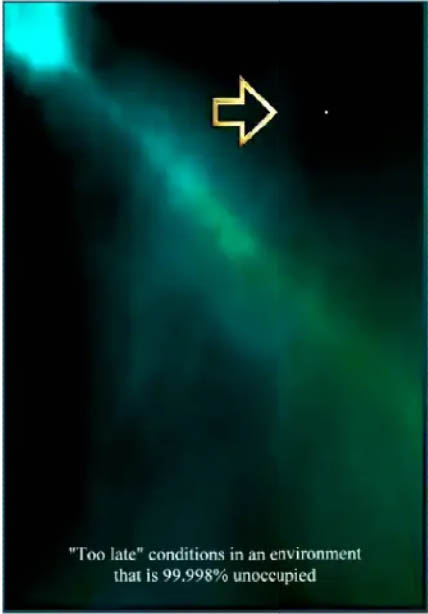
Why? Because the cumulative lifetime impacts inflicted by (or in behalf of) an average industrialized human being are tens, hundreds, or even thousands of times greater than those of an individual reindeer or unicellular dinoflagellate. (For example, neither the dinoflagellates nor the reindeer herds assessed here were technologically advanced organisms with, for instance, chainsaws, earth-moving machinery, coal mines, automobiles, long-line fishing fleets, nuclear wastes, shopping malls, and other means by which to speed, magnify, and amplify the degree, extent, rapidity, and efficiency of their individual and collective impacts.
This means that the ongoing, additive, worldwide, and cumulative adverse impacts that we collectively exert are inflicted by fewer individual humans, take place far more rapidly, accumulate more quickly, and reach cumulative values boundaries, limits, and thresholds far sooner. And as a result, they reach and potentially breach ecological limits sooner, more rapidly, and/or at an earlier moment in time.
Thus, imagine applying an average or industrialized ecological footprint (Rees, 1992, 1996; Wackernagel and Rees, 1994) for the whole of humankind, taken together, (or an average person's "ecological damage-trail" after K. Thomas, 2010) or a similar approach to estimate potential worldwide population-environment thresholds for a modern and industrialized human population of humankind. In this way, humankind's wastes, damages, impacts, and eradications are inflicted on a wider scale, and accumulate with greater speed, so that our collective adverse impacts carry us toward systems-failures thresholds tens, hundreds, or even thousands of times more quickly than unindustrialized populations of reindeer and unicellular dinoflagellates.
Lastly, beginning with the first atomic tests at Alamogordo, New Mexico in 1945, humankind began to realize that dropping J-curves into complex equilibrial systems is not, perhaps, a particularly good idea. Note therefore, that the population graph shown below is most emphatically not an s-curve, but instead exhibits a quite pronounced J-shape — which humankind is unleashing upon the only planetary life-support machinery so far known to exist anywhere in the universe.
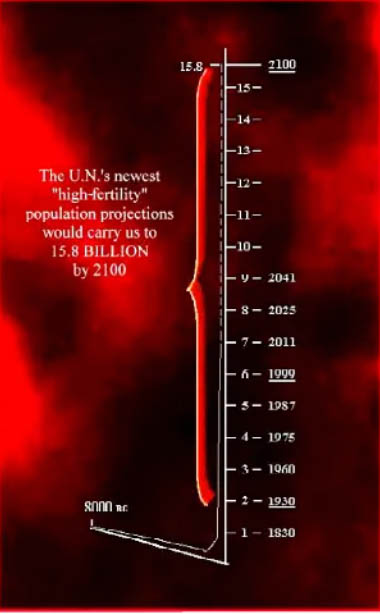
In the past, we have always been able to count on the functioning of earth's natural systems as a given. Today, however, our population has already become so large, and is continuing to grow larger so rapidly, that such presumptions are no longer warranted. (Try to imagine, for example, a team of astronauts in a space vehicle if they were to cannibalize 95% of their guidance and propulsion systems, annihilate 93% of their heat shields, destroy 87% of their CO2 scrubbers, degrade 77% of their computer codes, and eviscerate the other life-support systems of their spacecraft.)
In a similar way, try to imagine the owner of a new and pristine automobile who begins to systematically degrade its multiple operating systems, degrading 50% of its steering system, 75% of its tires, and then destroying its carburetor, most of its spark plugs, half of its axles and brake shoes, and 93% of its ignition and electrical systems, while simultaneously pouring additional contaminants each day into its gasoline, oil, radiator, battery, transmission fluid, and brake fluid. And then suppose that this individual can't understand why his automobile, which "has always worked in the past," doesn't function anymore. Not so bright, is he?
Do we know anyone who seems to treat the only planetary life-support machinery so far known to exist anywhere in the universe in a similar way? No rational astronauts, of course, would ever dream of inflicting such damage upon the vehicle that sustains their lives in space, and the rest of us would never dream of inflicting such levels of damage upon our automobiles — or upon the complex equilibrial systems of our own bodies and expect to even survive, much less continue to function as normal.
Amazingly, however, we seem to suppose that we can systematically destroy, eradicate, and dismantle the only planetary life-support machinery so far known to exist anywhere in the universe in a similar way.
Why should we suppose that earth's biospheric life-support machinery is invulnerable?
Notice that the above has nothing to do with "running-out-of" food or resources or anything else but instead counsels the urgency of caution when it comes to the degree of sheer physical eradication and damage that we are inflicting on earth's critical biosphereic machinery. See appendices which follow for details and mathematics of the three data sets assessed.
Randolph Femmer, Senior Advisor,
Biospherics Literacy 101 and The Wecskaop Project
What Every Citizen Should Know About Our Planet
Appendices
I. Graphs of Human Population Growth
8000 BCE to 2100. First note the pronounced J-curve shape in each case; Also note that even J-curves begin to show signs of slowing near the end of their progressions (even J-curves, after all, cannot rocket upward forever), except that, unlike logistic, sigmoid, or s-curves, in the case of a J-curve, such slowing does not denote a gradual transition to a balance state of equilibrial interaction — but instead characterizes the moments immediately preceding the data set's sudden plummeting to a value of zero.

The graphs incorporate 2011 U.N. medium-fertility (left) and high-fertility (right) world population projections to 2100.
Note that anything even close to the 15.8 billions depicted above right would constitute the demographic equivalent of a collision trajectory with a near-earth asteroid — and do not even contemplate the possible human implications of life-extension research that has already achieved six-fold life extensions in laboratory organisms — (an equivalent extension in humans would result in healthy, active 500 year olds and would require replacement fertility levels of 2/10ths of a child per woman per century.)
-------------------
2. For Math and citations, see original source.
No date seen, last reference 2012.
Also see:
What Every Citizen Should Know About Our Planet, 2011 (actually it is not 'our' planet)
SUBNOTE TO FILE: 7-21-2022
... and the short of it? We are rationalizing animals committed to a social system (a form 3 techno-industrial civilization) that is not remotely sustainable. The hard data and cold equations (Nature) are trying to tell us that to avoid collapse of a one-off plague-phase overshoot population, any successful intervention would need to be three or four doubling-times prior to climax of the system. In the case of reindeer on St. Matthew Island, that would have been when the population was about 600 (375 to 750). One more doubling would be 1200, the likely maximum long term carrying capacity limit. At 600, 'slamming on the brakes' might have allowed the population to remain below carry capacity and avoid degrading the island's environmental primary productivity. There are always time delays between 'slamming on the brakes' and coming to a stop. A second doubling puts the population at 2400, and a third doubling would reach 4800, locking the herd into a near-term 99% die-off as one more doubling to 9600 was biophysically impossible.
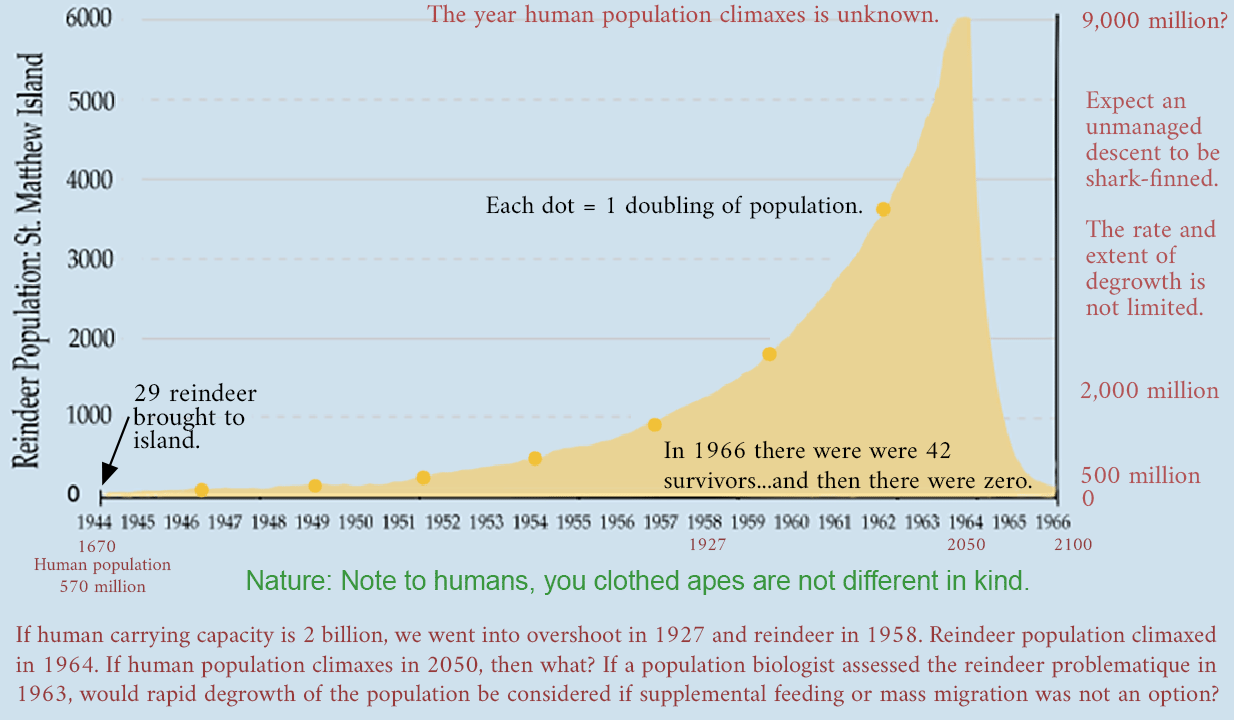
Humanity's 8 billion could not double again (likely guess). That it will not due to lowering fertility rates is not to sidestep the condition of overshoot which we are well into. Any objective accounting of our predicament notes that our plague-phase overshoot event started when our population reached somewhere between one-eighth and one-sixteenth of whatever our climax population is. Assume 9 billion. So to avoid a die-off event we would have had to 'slam on the brakes' or otherwise intervene to alter our trajectory when our population was 9/8th to 9/16th, or between 1,125 million and 562 million. So if when Thomas Malthus wrote his essay, all literate humans had read it within two years (by 1800), and being rational understood the implications of continued geometrical growth, then humanity maybe could have transitioned to a steady-state condition without any die-off. But such was the road not taken. The bigger we get (by kicking the growth can further), the harder we'll fall and the greater environmental degradation will lower carrying capacity.
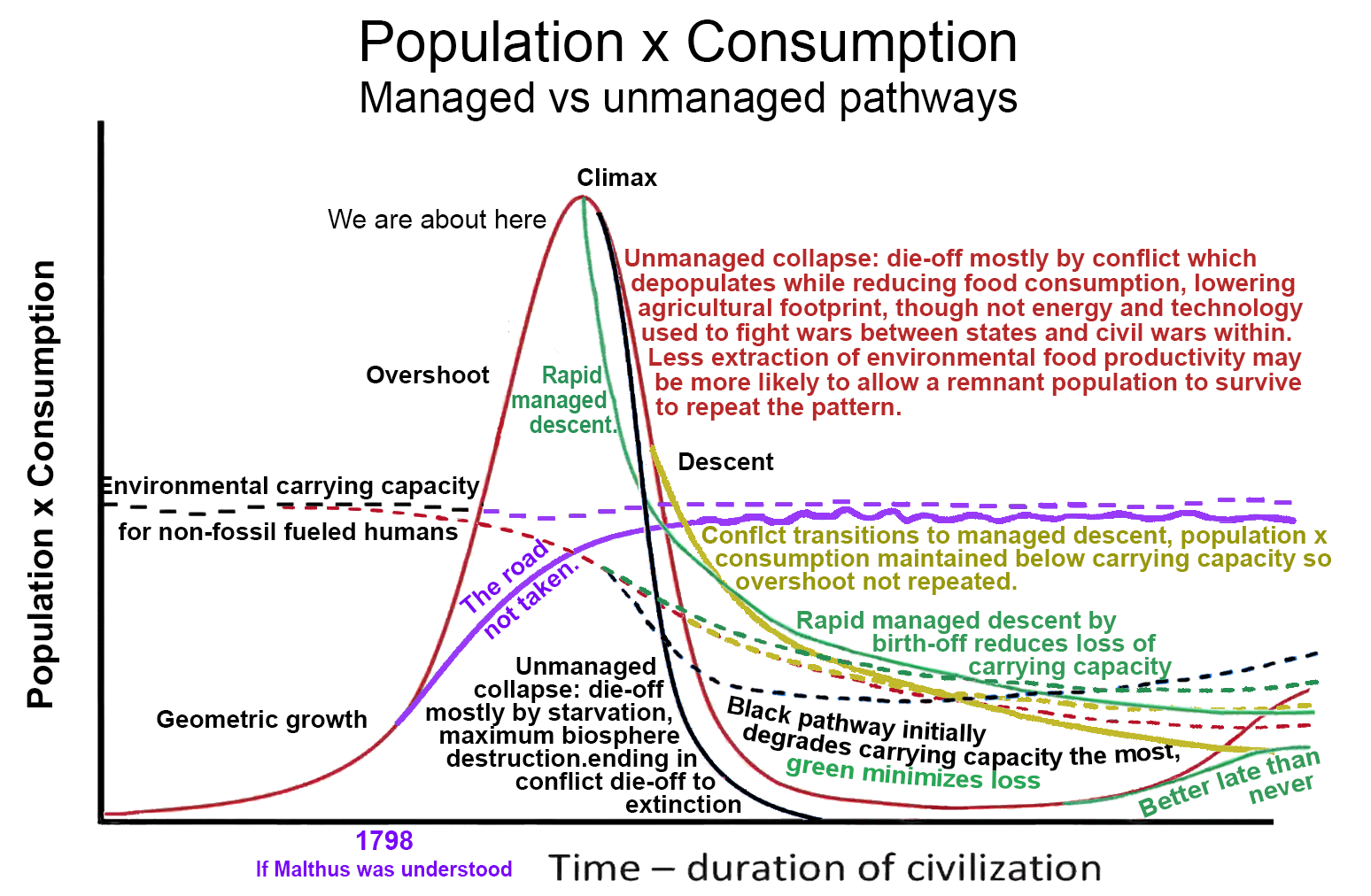
Note that from the POV of life on Earth (apart from co-mutualist livestock, pets, and disease organisms) Earth's biodiversity loss would be minimized and recover quicker if humans were to go extinct within the next century. But a longer view, assuming a managed descent via rapid birth-off and a viable ecolate civilization becomes the norm, one of a humanity that worked towards Nature restorancy as the millennia/eons passed, then recovery of biodiversity could take less than 10 million years. Whether humans emerge from the coming bottleneck, and if so, what sort of human emerges (e.g. illiterate weaponized marauders?), the coming decades will reveal.
I have occasional (and unpredictable) access to the Wayforward Machine that is linked to what, in 2353 CE, is called the Wayback Machine that can transmit information to what I call the Wayforward Machine. A recent communique may be of interest:
Message from Posterity
Accessed 35V403 (June 23, 2353) via Wayforward Machine
Sensai Omio asked her higher school systems science students to write a message to humanity past. The essay judged best by the students was rewritten somewhat and placed in the wayback machine, to be delivered to the year 2022 CE (our time, year 72 AA their time). The resulting letter (to us):
Dear Ancestors:
We, the 13 million of the United Federation of Watersheds, greet the 8 billion techno-industrialized humans of your time. Those who came before us, but after you, did have some complaints. Many wished they could live as you do, whether as subsistence farmers who also supply bushmeat to urban dwellers to make $2/day average to buy shoes and occasionally a soda for themselves and their children (and perhaps in a few years to save up enough for a used bicycle), or some would even prefer to live as a wage slave living in the expanse of a mega-city (for a time) in a high-rise apartment.
But for us the days of lament have passed. There are actually 37 million humans on the planet, but the 24 million who still live on the downslope pose no serious threat to the Federation in our time. They can only hope to successfully attack one another, do, and so become ever fewer. They have lived as marauding takers for 13 generations, and that is the life they know. It is now more likely for some members of the outlying regions (those having foresight intelligence) to migrate to a watershed area bordering the Federation, and instead of attacking those living within Federation limits (imposed upon all members as all agree to), they seek instruction and guidance to found a new WMU (Watershed Management Unit) able to live within limits enough to apply for Federation membership (which if accepted, gains them Federation Embassy services, trade benefits, belief therapy, and protection from the remaining marauding hordes (in return they agree to live within limits and send Guardians to assist any Federation member attacked by any of the remaining marauding ones as would-be empire builders).
We envy you nothing. A few of you will understand enough, will come to listen..., to thereby become our ancestors. Most of you, the 99+%, do not live viable lives, so how could you beget viable descendants? Few of your progeny will die of old age or come to live in a viable culture.
There is nothing we would have you do differently. So keep on keeping on unto your dissolution (or in some cases, persistence). All may intend to persist by way of becoming ancestors, but none of you determine what a viable life is. You can guess, then test, but humans do not select for what works to persist. Some will understand, and during the Great Selection will endeavor to listen to Nature who has all the answers.
We are 331 years in your future. If we were 50 years in your future, we would revile your very existence, regret that you had ever breathed our air, as we could think to do nothing other than blame you for our ghastly present. But even in 2072 some few did not traffic in blame and justification, in for and against thinking, but sought only to love and understand this planet, and to live with it properly (as distinct from believing that they love and understand the planet, and live with it properly).
Such ones became our ancestors, genetically and memetically, and we have no complaints, unlike you, who have every reason to have many. You have no choice but to understand (and pass it on), or die (and leave no trace). You have no choice because you do not determine what works. To understand this is to have a life-driven purpose such as all who became ancestors, going back nearly 4 billion years, had.
Enjoy life while you can, young'uns.
SS Class, Federation Academy
403 years after your Great Acceleration
Whose climax you approach
SUBNOTE TO FILE 7/23/2022:
...and just because I also read The Alienated Planet: Saving Life on Our Majestic Planet by Farid Pourkhatai
A short book, 31 pages, I read the Kindle Edition. The author speaks from two domains of discourse (i.e. with a forked tongue). He can speak in fluent science-speak, and I can sing along, but then he lapses into left-leaning political-speak. In Wittgensteinian speak, he plays two language games, mixing them together. This is what compatiblists do. They inhabit two or more domains of discourse/belief systems/social constructs, play different language games (perhaps very well), and conflate them, which creates the need to reconcile them by insisting, in clever ways or not, that the two games are compatible. Science literate and religious minds are common compatibilists, but increasingly the conceptually science literate (including concept mongers) also have a felt need to assert political verities.
 Mathematics is one language game. Theology is another. A mathematician who is both may fill a chalkboard with equations, with one step being 'and then a miracle occurs', followed by more equations. To a mathematician who is not also a theologian, the thoughts offered are incoherent.
Mathematics is one language game. Theology is another. A mathematician who is both may fill a chalkboard with equations, with one step being 'and then a miracle occurs', followed by more equations. To a mathematician who is not also a theologian, the thoughts offered are incoherent.
So I'm singing along, and then 'anthropocentrism... the notion that humans viewing themselves as the most important entity in the universe, is the obsolete and unscientific belief, even more regressive than geocentrism, as it encompasses nationalism, racism, and sexism. In addition, this procured narcissistic behavior is clearly responsible for our exponentially increasing ecological footprint.' and 'malignant corporations mismanaged material and energy resources in the post-petroleum era. This clearly confirms the flawed mainstream ideologies that directly or indirectly support colonialism, patriarchy and sexism, racism, and ultimately anthropocentricity.' and 'most prevalent Western curricula are intentionally designed to promote the current economic model. It justifies and encourages overextraction, overconsumption, and waste generation. Simultaneously, it promotes sexism, racism, colonialism, and anthropocentrism.' and 'contrary to what capitalists believe, the reversal of humans' actions cannot be achieved through total government control. "The tragedy of the commons" is still taught uncritically as a justification for Feudalistic views or even environmental failures.'
The author uses 'clearly' 13 times in 19 pages of text ($4.99 e-essay). I view the usages as short for 'I feel the need to assert'. The 'flawed mainstream ideologies' are 'clearly' those of the not sufficiently progressive left-leaning Woke who are anthropocentric in contrast to the truly progressive and properly educated who are clearly not anthropocentric, just as a wolf dressed in sheep's clothing is clearly not a wolf.
Our problematique may be clearly stated in science-speak terms, but the view that there are political solutions, provided the properly enlightened (by a science ideology) political ideologues are in power, is a 'and then a miracle occurs' insertion in the story. To repeat what Nature repeatedly tells me: There are no true stories (but conceivably some stories are better than others, sometimes).
